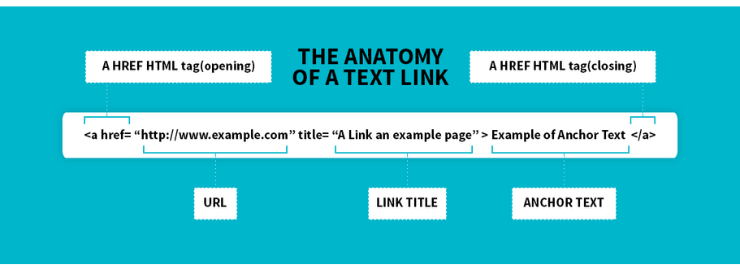Anchor tags (or <a> tags) play a crucial role in HTML, allowing us to create clickable links that connect web pages. While they may seem simple, anchor tags contain attributes that can significantly impact Search Engine Optimization (SEO). This article will explore the different parts of an anchor tag and delve deeper into the Rel and Target attributes, their values, and how they influence SEO.
Anatomy of an Anchor Tag
Let’s start by understanding the components of an anchor tag:

Understanding the anatomy of anchor tags is crucial for effective web development and search engine optimization (SEO) strategies. By grasping the different components of an anchor tag, such as the opening and closing tags, href attribute, anchor text, title attribute, and the rel and target attributes, you can create well-structured and optimized links on your webpages.
1. Opening and Closing Tags
Opening and closing tags are important components of anchor tags that define clickable links. The opening tag, denoted by <a>, indicates the beginning of the link, while the closing tag, denoted by </a>, marks the end of the link. All content that should function as a link is placed between these tags.
2. Href Attribute
The “href” attribute defines the destination URL to which the link leads. It specifies the webpage, file, or resource that the anchor tag will navigate to when clicked. Example: href=”https://www.example.com“
3. Anchor Text
The anchor text is the visible and clickable text within the anchor tag. It is the part that users interact with to navigate to the linked page. It is enclosed between the opening and closing tags. Example: <a href=”https://www.example.com”>Click here</a>
4. Title Attribute
The optional “title” attribute provides additional information about the link. When users hover over the anchor text, the title attribute displays as a tooltip, offering a brief description or clarification. Example: <a href=”https://www.example.com” title=”Visit Example”>Click here</a>
5. The Rel Attribute and Its Values
The “rel” attribute describes the relationship between the current and linked pages. It influences how search engines interpret and handle the link. Here are some commonly used values and their impact on SEO:
- rel=”nofollow”: When applied, this value instructs search engines not to follow the link or pass any authority to the linked page. It is commonly used for user-generated content, paid links, or to prevent the crawling of untrusted links.
- rel=”noopener” and rel=”noreferrer”: Adding these values to external links enhances security by preventing potential security risks, such as phishing attacks or access to the referring page’s information. While they don’t directly impact SEO, they are recommended for safer browsing experiences.
6. The Target Attribute and Its Values
The “target” attribute determines how the link opens when clicked. Although it doesn’t directly influence SEO, the choice of target values affects user experience, which can indirectly impact SEO. Let’s explore some common target values:
- target=”_blank”: This value opens the linked page in a new browser window or tab. While it provides convenience for users to keep the original page open, excessive use can lead to higher bounce rates, potentially signaling to search engines that the linked page lacks relevance or engagement.
- target=”_self”: This is the default value, opening the linked page in the same window or tab. It is generally recommended as it keeps users within the same browsing session, reducing bounce rates and improving user experience.
- target=”_parent” and target=”_top”: These values are used in frameset or iframe scenarios to specify where the linked content should open. They function similarly to target=”_self” in terms of SEO impact by maintaining user engagement within the same session.
Understanding anchor tags’ intricacies and attributes is essential for effective SEO strategies. While the “rel” attribute defines the relationship between pages and the “target” attribute determines how links open, their direct impact on SEO is relatively limited. However, using them wisely and considering user experience can indirectly improve SEO performance.
Remember, providing valuable content, optimizing anchor text, and ensuring relevant and reputable link destinations remain crucial aspects of SEO. Leveraging anchor tags effectively can enhance user experience and strengthen your website’s visibility in search engine rankings.
Make sure to check out our other article about AI Content Creation.

